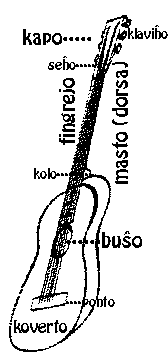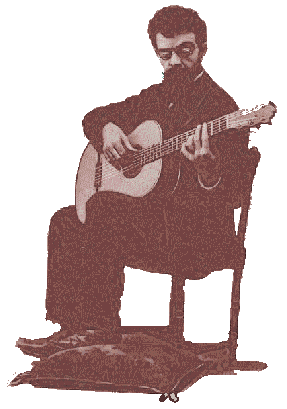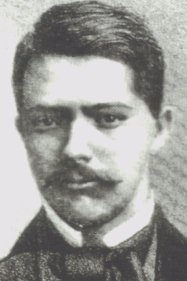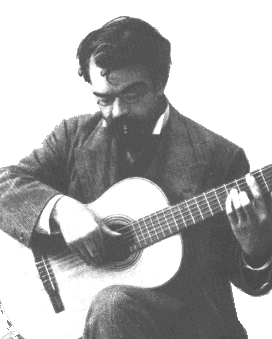 .
Let me introduce you to my music making tool..
.
Let me introduce you to my music making tool..
Because of several reasons: music has always been regarded as an international language, the same as Esperanto. Our maestro's music is an asset of Human kind, the same as Esperanto.
However, I have translated the full document into English from the Original in Esperanto. Also, if you can read Spanish, you can read the Spanish translation of this document, which I did myself as well.
Good afternoon, ladies and gentlemen, and thanks for coming to listen to my musical talk.

I am honoured to talk here, in Castellón, on an important Castellonian, Mr. Francisco Tárrega Eixea, born near this city, in the town Villareal de los Infantes (Royal Village of the Princes). In 1273 King James I The Conqueror set up his camp there when besieging Burriana, a nearby town. After he conquered it from the Muslims, he ordered a palace, a chapel and a town to be built for his children, and so he called them Royal Village of the Princes (that is: Villareal de los Infantes), four miles away from here.
Nearly 600 years later, on November 21st 1852, it was born there Mr. Francisco Tárrega Eixea, the guitarist and composer who this speech is about. When I was twelve and the Three Wise Men brought me a guitar, the first piece I learnt was this one mazurca [PLAY MAZURKA IN LA]. Then I did not know who was its author. Later I learnt that it was a gentle juvenile piece by Francisco Tárrega.
But before my speech progresses, let me point out that I am not a concert player, but a guitar teacher. Not every guitar player is a guitarist. It is true that I obtained a professional guitar certificate at Conservatory, that I know about guitar and that I am able to teach on what is to be done to end up playing the guitar well. I can even invent proper exercises to overcome specific difficulties of my guitar pupils. However, I lack the possibility to practice for long hours every day, to improve my sound, to make that charming string sextet cry, to make it sing with joy, to vivify my instrument. Thus you cannot expect a concert from myself: I can only offer you a talk, a clear explanation about guitar and what was done with it by one of our best citizens, moreover, a citizen of Castellón de la Plana.
To explain this properly, however, I must add a few words about
guitar itself. During my first
guitar talk within the European Esperanto Forum in
1997 in Valencia, I realised that
guitar was still unknown by many .
Let me introduce you to my music making tool..
.
Let me introduce you to my music making tool..
Guitar is an instrument coming from Eastern sitar, brought to us by the Muslims when they invaded the Iberian Peninsula back in the VIIIth century. In its actual condition it has six nylon string, three of which are coil-covered with a very thin metal thread from end to end. This is done so that their sound is lower (graver). The guitar parts are: head (kapo in the figure), mast (masto) and body (korpo). In the body there is the mouth (buŝo), through which you can see the maker's name. Mi guitar was made in Valencia by Vicente Sanchís Badía, and I bought it in 1967. The strings are tied to the head by means of pegs (klaviĥoj) and to the bridge (ponto) in the other side. There are 18 frets and two halves along the mast so that the fingers can find the exact place where every note is. The place where you can press with your fingers, between the frets, is called the fingerboard (fingrejo). So that the string can sound open there is a plastic piece at the beginning of them, called ceja (seĝo, which used to be made of bone. When you need a chord to sound sharper, you can use a finger ceja or little ceja, that is to say, cejilla (seĝeto) by pressing with your spread left index across all six strings at the same time, in this way: [PLAY E CHORD AND THEN MOVE IT UP TO THE THIRD, FIFTH AND EIGHTH FRETS]. The strings are called according to their numbers [PLAY THEM OPEN ONE AFTER THE OTHER] the sixth, the fifth, the fourth, the third, the second and the first. The latter is also called the prima (or chanterelle, in French), and the sixth, the bordón. The prima usually sings the melody, and the bordón accompanies it. The other strings provide harmony and give that charm which is so characteristic of the guitar, which makes it more worth while listening to than other masted instruments which we cannot usually listen to any more today, like the lute, vihuela (or hand viola, as it was also called in the past). Vihuela and guitar were in concurrence for centuries in Spain, and while the former was played by the gentry, the latter was played in humble homes and in work places, mainly barber shops. At the end the guitar won, due -in part- to the gypsy flamenco chants, which were not really gypsy or flamenco (this word means Flemish in Spanish...), but we'd better leave this for a further talk. I will only say that the vihuela could not sing like this without being in danger of destruction: [PLAY FLAMENCO FALSETA]. If you try to play this on a vihuela, its cover would probably collapse. No, the themes played in the vihuela sounded like this: [PLAY THE PAVAN BY MILÁN]. But let's imagine this melody played with a greater delicacy, more quietly, showing more fragility... (after all, guitar is not a vihuela!)
But if guitar won the contest against vihuela in Spain, it iwas so thanks to the activity of many anonymous popular players, after who there came many famous guitarists, among whom there are Santiago de Murcia and Gaspar Sanz. After them there were other guitarists about whom we know a lot more: Federico Moretti, Fernando Sor, Dionisio Aguado, Julián Arcas..., and our Francisco Tárrega Eixea. There are also other names, some of them not Spanish, like Italians Ferdinando Carulli, Mauro Giuliani or Mateo Carcassi, not forgetting Hungarian Johann Caspar Mertz or Bohemian Wenceslaus Matiekga, among many others.
But when our guitarist was born, guitar was a well known instrument in Spain, but as a popular, not cultured level.
Francisco de Asís Tárrega Eixea was born on November, 21st 1852. His father, Francisco Tárrega Tirado, was an usher, and his mother, Antonia Eixea, was working as a messanger for a neighbour nunnery. That is why they had to leave little Quiquet to the care of the mercenary hands of a young girl. On one occasion the little boy was crying tirelessly, and the girl had no better idea than throwing the baby to a nearby canal. A neighbour saw such a horrible thing, and he ran and took the baby just in time to save his life. However, he got from this a strange illness which nearly cost him his life, and the consequence of which was that his eyes were affected for life, and he never recovered, even after several operations. The girl went away, and nobody ever knew about her again.
Soon after this, the family moved here, to Castellón de la Plana, where the father found a position as an usher at the Casa de la Beneficencia (House for the needed). Some years later the mother died, and the children were educated at home, and at school, very little at church, but mostly in the streets of Castellón.
Our Paco's first teacher was the Cego de la Marina, the blind man in the marina, because he used to play the guitar and beg there. Little Quiquet managed to become the friend of this blind man, called Manuel González. He taught the child all those sounds which charmed him so much. After that he got tuition on guitar by don Basilio Gómez, and even Julián Arcas, the best guitar player in Spain at that time, taught him. But before this, his father wanted the child to learn music seriously, and so he asked Mr. Eugenio Ruiz to teach his child piano and music reading.

Julián Gavino Arcas had been born in María, a town in Almería, and he learnt to play guitar with his father from the Método de Guitarra (Guitar Method) by Dionisio Aguado García, whose music is still learnt in our conservatories. The programs for his concerts consisted largely of fantasies written by himself on opera themes, varied themes and folk dances and songs for guitar solos, which enhanced their interpretation and importance. Guitar was still, however, an unimportant instrument, but in spite of this Julián Arcas was already an important artist in that Spain. Soleá, Jota aragonesa and Panaderos were his three most widely known works, according to Emilio Pujol. I will play a fragment of each one o them for you. Soleá is one of the palos or original chants of flamenco, that Spanish-gypsy music. [PLAY SOLEÁ].
Now I will play a fragment of the Jota aragonesa, which inspired the famous work by Tárrega with the same name, a few years later. [PLAY JOTA ARAGONESA]. Finally, Panaderos is a Spanish dance similar to the ZAPATEADO, shoe dance [PLAY PANADEROS].
This concert player visited Castellón de la Plana and played a concert in February 1862. Our little Francisco was very deeply impressed, so his father and friends asked the concert player to listen to the little boy. He played so well that the maestro agreed to teach him in Barcelona, where he lived then.
The ten year old boy went there a few months later..., but the maestro could not teach him then, because he had to go to Britain on a concert tour, mainly for the nobility, and even the Duchess of Cambridge sponsored several of these concerts. The boy's disappointment was great, after all the sacrifices of his father, after spending all his money to go to Barcelona, there was no benefit. Francisco Tárrega was only ten years old, and he may have had a romantic idea about guitar winning fantastic wages for him..., and no sooner said than done: he ran away and he started a musical career on his own along coffee houses and restaurants in Barcelona, the most famous of which was Falcon, and then the customers would give him some coins.
But the landlords contacted the father, and the poor man had to sell some goods of his to pay for the train ticket to Barcelona to look for his child. Finally he found him on the street, playing his guitar. The father had no money to come back to Castellón, so little Quiquet had to go on playing the guitar to get the train tickets. He had to play for money on the train itself to finish paying for the trip back home.
After coming back, father decided to make further sacrifices for his son, and so he paid a famous music teacher to have his son learn piano and music, since guitar in those times had no prestige. Eugenio Ruiz, also a blind man like the mentioned Cego de la Marina, realised soon that little Francisco was really thirsty for music.
Three years later, in 1865, he ran away again, but this time he walked up to Valencia, where he joined a gang of gypsies which protected him, and then they sang and asked for money from the passers-by. The father had to go after the son again, also by walking (70 kilometers to the South). Then he made his son come back. But he flew away a third time. During his second stay in Valencia, he met a Count who wished to protect him, but his gypsy firends did not want to renounce listening to his playing, so they invaded the Count's place. The Count was terrified by such an invasion, and he made Tárrega choose: either he or the gypsies. Quiquet chose the latter, and so his possible formal tuition with expensive teachers ended. But life was music for him, and music was his life, as we shall see now. Several months later he went back home because the family's economy was getting worse, and he contributed working as a pianist at Burriana Casino. There he met Mr. Antonio Cánesa de Torres. This gentleman was very important in our artist's life: he supported him financially, and he even took him to Seville, where he bought him a guitar by Antonio de Torres. Antonio de Torres was very important in the development of modern guitar, as he made the last major reform in the instrument, making it larger. His contribution is so important, that today's classical guitar is what then was called La guitarra de Torres, that is, Torres' guitar. Standard guitars then were smaller and they sounded more softly. He also was the first guitar maker who used mechanical pegs (clavijero mecánico) in guitar making, and he is regarded as its inventor. Before him, pegs were made of wood, which sometimes we see inflamenco guitars.
When Francisco Tárrega was 22 years old he could -at long last- study at the Royal Conservatory of Madrid. He had made a living from music for 14 years then. At the conservatory he studied solmisation, piano and harmony, but his teachers knew aobut his guitar activities, and they all asked him a formal concert at the Conservatory stage, because knowing their pupil's love for music, they could not understand he should waste his time in such an unworthy instrunment instead of piano. After the concert, Mr. Emilio Arrieta, Headmaster of the Conservatory and opera writer, advised him never to leave guitar for piano, out of the impression his guitar playing made on him. After this success, he was asked to play at the Alhambra Theater in Madrid. After his premiere there, Tárrega started a series of bright concerts which he suspended only in Castellón, not to concur with Julián Arcas while he was in town.
In 1880 Luis de Soria, a pupil of Arcas and friend of Tárrega, fell ill and so he could not play a concert in Novelda (Alicante). He asked his friend Francisco Tárrega to play in his place, and after the concert an important man in town asked the artist to listen to his daughter, María José Rizo, who was learning to play guitar. In that moment they started a relationship which ended in their wedding, the following year.
But before that, Tárrega premiered in the Opera Theatre in Lyon and then the Paris Odeon, in the Second Centennial of the death of Pedro Calderón de la Barca, in a concert which had been organised by an international committee the president of which was Victor Hugo.
After that he also played in London, but there he liked neither the language, nor the weather, nor the fog. There is a story about his stay there. After a concert, some people saw that the maestro was a little sad. What is the matter, maestro? Do you miss home? Your family, perhaps? They advised him to capture that moment's sadness in his music. Then he conceived the theme of this work, called Lágrima. [PLAY LÁGRIMA].On Christmas 1882 Tárrega married María José Rizo, and they moved to Madrid, gaining their living by teaching privately and playing concerts. However, he did not earn enough to live, so they had to move to Barcelona, where interest for the guitar was greater than that in Madrid, hoping their life would be easier. Among their Barcelona friends were, after a little time, Isaac Albéniz, Enrique Granados, Joaquín Turina and Paul Casals, true milestones in our musical and cultural life
In that time there was Doña Concha Martínez, a rich widow who wanted to protect the artist. She managed to convince him to dwell, together with his family, in her Barcelona home. Later she took the maestro to Granada, where he conceived the theme for his famous Alhambra Remembrances, which he composed on his return and he dedicated to his friend Alfred Cottin, a Frenchman who had arranged his Paris concerts.
Doña Concha's protection lasted about three years. Though I suppose you all know the piece I have just cited, I will play for you probably Tárrega's most famous piece: Recuerdos de la Alhambra. [PLAY RECUERDOS DE LA ALHAMBRA]In 1900 Tárrega visited Argel, where he heard a repetitive rhythm played on an Arabian drum. The following morning he composed his famous Moorish dance (Danza Mora), based on that rhythm. He went on composing and adapting other people's famous music for guitar till his death, on the 15th of December of 1909.
Let's analyse now what is the so called Tárrega's School. According to the Argentinian guitarist and composer Julio Salvador Sagreras, it has four basic factors:
Flesh and nail.- At guitar interpretation there are two different ways conceived by two guitar players who were friends: Fernando Sor and Dionisio Aguado. The former did not use his nails when playing the guitar, whereas the latter was a convinced partisan of its use. The former way is more secure, but the latter one is more brilliant. Fernando Sor wrote a guitar duetto the first part of which must be played with nails, and the second part is to be played without them. But what did Tárrega say about this? He first played with his nails, but little by little he cut them shorter and shorter, till shortly before his death he said he finally had found the exact length to play the guitar well. Unfortunately, he did not leave his finding by written, and only his brother Vincent knew the details about it. But being he a violinist and not guitarist, he could not repeat the technical details his brother told him just before he fell struck by his fatal illness. Emilio Pujol tells us that his maestro had very little nails in his right hand. Thus we can conclude that Tárrega did not follow Sor or Aguado exactly, but he had an eclectic position between the two of them, or if we understood Pujol's The Dilemma of Timbre on the Guitar, he evolved from Aguado to Sor.
Our question is treble:
The last question can only be supposed. But we can draw some conclusions from the other two answers.
Let's consider the second one:
So there is the question What did Tárrega really contribute? Could we talk about before and after Tárrega? Of course we can! Tárrega's musical foundation was very solid. He saw the same problem as Fernando Sor had seen earlier: to play well, you need a full musical experience which includes knowledge of harmony, composition and piano, together with a huge passion for the guitar. These qualities added to an iron-like sense of discipline for study took him to success as a concert player.
Francisco Tárrega was very shy, and thus he
preferred playing just for his friends. In addition, he was very
religious, deeply self-giving and he loved those near him.
During all his life, society admired violin, piano, string
quartet and orchestra; however this Guitar Sarasate
achieved a great importance for himself and for his instrument,
guitar. This is what Tárrega contributed: himself. His passion
for guitar and the possibility to transmit it to his listeners,
so much to the public, as to his protectors and to his
disciples. He did not succeed, however, about one single
important thing: he did not look at the past of the guitar.
Maybe because he was too humble, he did not think that you've
got to defend yourself, your culture, your roots. Tárrega
thought that to include guitar among the cultured instruments,
he had to transcribe those works created for the violin,
violoncello and piano by the great masters, such as Johann
Sebastian Bach, Wolfgang Amadeus Mozart, Ludwig von Beethoven,  Frederic
Chopin and others with similar importance. This influenced his
disciples, who also forgot the rich Spanish string tradition
which was nearly ten centuries long. As a consequence, they went
on transcribing and encouraging the great composers create works
for the guitar. But they forgot the aesthetics of Luys Milán,
Alonso Mudarra, Gaspar Sanz, Santiago de Murcia and many other
valuable composers of ours. Harpsichord, instead of lute, was
transcribed from.
Frederic
Chopin and others with similar importance. This influenced his
disciples, who also forgot the rich Spanish string tradition
which was nearly ten centuries long. As a consequence, they went
on transcribing and encouraging the great composers create works
for the guitar. But they forgot the aesthetics of Luys Milán,
Alonso Mudarra, Gaspar Sanz, Santiago de Murcia and many other
valuable composers of ours. Harpsichord, instead of lute, was
transcribed from.
Francisco Tárrega took advantage of a new attitude towards guitar expressed by Julián Arcas' works. This attitude was close to folk songs, so much that today the Almería guitarist is cited as one of the best flamenco players in some anthologies on this guitar style. Tárrega's music was also populised, that is, permeated by folk feeling; though not being he a man from the South, but the East of Spain, even if he composed a little Malagueña he did not leave us any Soleares, Soleá or Panaderos, but he left us a great Gran Jota de Concierto, in which guitar sings in many different ways, which I will try to make you hear to end my talk with [PLAY THE GRAN JOTA]
Castellón, April, 4th 1998
Jesuo
de las Heras
ACKNOWLEGEMENTS.- I could not finish this talk without thanking the following guitarists:
And don Francisco Tárrega, for everything else.